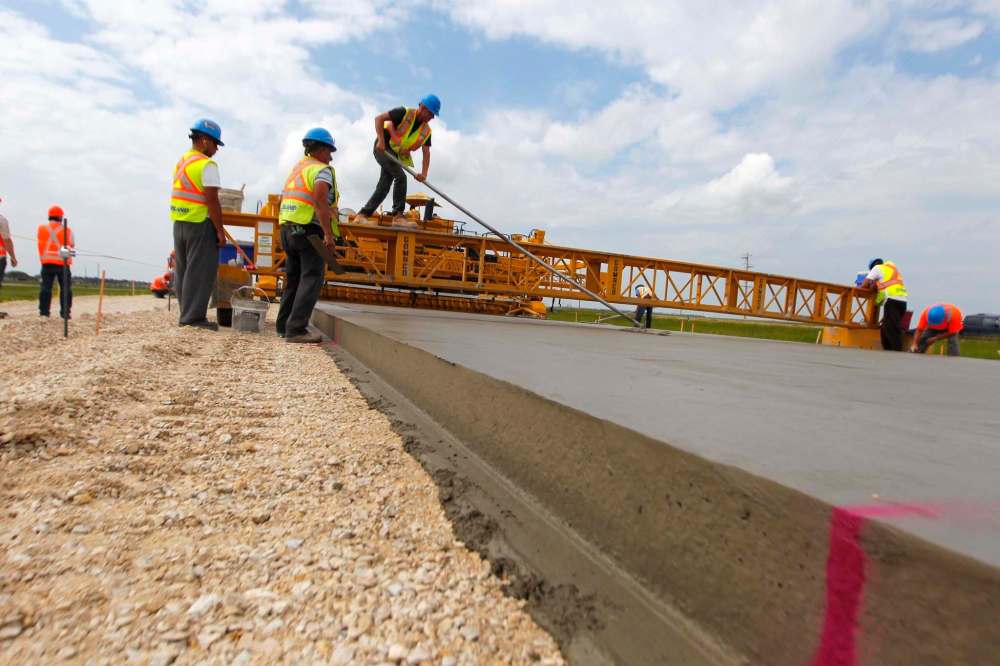Road to recovery paved with infrastructure investment
Advertisement
Read this article for free:
or
Already have an account? Log in here »
To continue reading, please subscribe:
Monthly Digital Subscription
$0 for the first 4 weeks*
- Enjoy unlimited reading on winnipegfreepress.com
- Read the E-Edition, our digital replica newspaper
- Access News Break, our award-winning app
- Play interactive puzzles
*No charge for 4 weeks then price increases to the regular rate of $19.00 plus GST every four weeks. Offer available to new and qualified returning subscribers only. Cancel any time.
Monthly Digital Subscription
$4.75/week*
- Enjoy unlimited reading on winnipegfreepress.com
- Read the E-Edition, our digital replica newspaper
- Access News Break, our award-winning app
- Play interactive puzzles
*Billed as $19 plus GST every four weeks. Cancel any time.
To continue reading, please subscribe:
Add Free Press access to your Brandon Sun subscription for only an additional
$1 for the first 4 weeks*
*Your next subscription payment will increase by $1.00 and you will be charged $16.99 plus GST for four weeks. After four weeks, your payment will increase to $23.99 plus GST every four weeks.
Read unlimited articles for free today:
or
Already have an account? Log in here »
Hey there, time traveller!
This article was published 13/04/2017 (3171 days ago), so information in it may no longer be current.
The Pallister government’s recent announcements on cost controls in public services had many wondering how bad the news from the 2017-18 budget speech would get. Yet the reaction coming from the legislature Tuesday was more of relief, not anguish.
The reactions of some groups (students, public-service unions) would differ, but most of those poring over budget papers found it to be middle-of-the-road stuff. Restraint? Yes. Austerity? Nope.
Finance Minister Cameron Friesen is controlling costs. Overall expenditures by core government departments this year will rise by 2.7 per cent over last year’s forecasted expenditures. Friesen has delivered on the central goal of wrestling with the deficit, cutting the budgeted summary deficit to $840 million this year.

So, with its second budget, the Pallister government has announced it has moved beyond “correcting the course” to “responsible recovery.”
But Manitobans should recognize this as a fragile recovery. The province’s gross domestic product is forecast to hit a modest two per cent this year. Last year, it was a mere 1.4 per cent.
This illustrates the real challenge. We need to see the GDP pick up steam.
At a Manitoba Chambers of Commerce breakfast Wednesday, Friesen acknowledged this. He said that, from this point on, the Pallister government should be judged not just by its fiscal performance, but by results.
Stepping on the gas on the “road to recovery” demands strategic, smart decisions on where to invest the hard-earned cash Manitobans pay in taxes.
Numerous studies have found investing in infrastructure pays dividends. The Federation of Canadian Municipalities pegs the return at $1.60 for every dollar invested; Standard and Poor’s in 2015 estimated that an investment of one per cent of GDP in trade infrastructure (highways, roads, ports, rail, etc.) “produced an economic return as high as 2.5 times, in a three-year period.”
Strong, efficient infrastructure moves people to jobs and goods to market. It makes possible the growth in trade, which heavily supports our GDP: 60 per cent of Canada’s GDP and fully 50 per cent of Manitoba’s $60-billion GDP are tied to trade. Those returns to government treasuries support critical services, such as health, education and public safety.
So it matters, a lot, where we invest public funds.
Government’s infrastructure budgets have been trimmed, down from the extraordinary levels seen in the last year of the Selinger government, as the focus shifted to deficit reduction.
But it’s not always about how much, but about how that investment is managed. First, we have to be disciplined about what is meaningful infrastructure investment.
Canadians last month saw some play on the definition of “infrastructure” in the federal budget. The Trudeau government stretched the meaning to include items never before contemplated — daycare spaces, for example.
Such redefinition is a political attempt to ride on the coattails of solid and substantial public support for investing in infrastructure (“Fix those potholes!”).
The Pallister government has wisely resisted such transparent silliness in Budget 2017. While it talks about “strategic” infrastructure, and includes health, education and housing in that basket, it has held to its election campaign promise to invest at least $1 billion in “core” infrastructure: highways, bridges, sewer/water and flood protection. Manitoba Infrastructure’s highways capital budget will sit, as pledged last November, at $502 million.
How do we ensure that investment keeps working for us?
First, the government can protect that level and therefore value of infrastructure investment with inflationary increases annually.
Second, let’s get an assessment of “Manitoba’s core infrastructure investment deficit,” a cost-accounting of what is outstanding and required and over what period of time to bring our highways, roads and vital trade corridors to good condition and keep them there. Let’s make sure, for example, that our border crossing at Emerson is efficiently moving traffic on Highway 75, which carries $26-billion worth of north-south trade with the United States annually.
Winnipeggers know what the city’s infrastructure deficit — $7.4 billion — is for existing and new infrastructure. Sadly, for 17 years the previous provincial government refused to share that information with the public. The Pallister government can distinguish itself in making that detail public, so we can have the discussion, backed by evidence, of where to go with strategic, sustained next steps. It would allow for goals to be set, and progress measured against benchmarks.
Friesen said Wednesday his government has turned the fiscal ship and gotten our province on course.
Budget 2017 has shown where we can go, with work. It’s important now that Manitobans can see the government is keeping our economy growing, and confidently so on a path to prosperity.
Chris Lorenc is the president of the Manitoba Heavy Construction Association.

